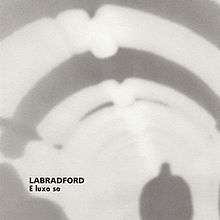E Luxo So
E Luxo So is the fifth studio album by the Virginian post-rock band Labradford, released on July 13, 1999 by Blast First and Kranky.[4] The titles of the album's six songs are made up of the recording and production credits. Track 4, "By Chris Johnston, Craig Markva, Jamie Evans", was used in several episodes of the HBO miniseries, The Young Pope.
| E Luxo So | ||||
|---|---|---|---|---|
 | ||||
| Studio album by | ||||
| Released | July 13, 1999 | |||
| Recorded | Sound of Music Recording Studios (Richmond, VA) | |||
| Genre | Post-rock, art rock, ambient | |||
| Length | 39:04 | |||
| Label | Blast First/Kranky | |||
| Labradford chronology | ||||
| ||||
| Review scores | |
|---|---|
| Source | Rating |
| Allmusic | |
| NME | (8/10)[2] |
| Pitchfork Media | (5.3/10)[3] |
Track listing
All lyrics are written by Mark Nelson; all music is composed by Labradford.
| No. | Title | Length |
|---|---|---|
| 1. | "Recorded and Mixed at Sound of Music, Richmond, Va." | 7:50 |
| 2. | "With John Morand and Assisted by Brian Hoffa." | 5:43 |
| 3. | "Dulcimers Played by Peter Neff. Strings Played" | 5:09 |
| 4. | "By Chris Johnston, Craig Markva, Jamie Evans," | 5:04 |
| 5. | "And Jonathan Morken. Photo Provided By" | 7:19 |
| 6. | "Leta O'Steen. Design Assistance by John Piper." | 7:59 |
Personnel
Adapted from the E Luxo So liner notes.[5]
|
|
Release history
| Region | Date | Label | Format | Catalog |
|---|---|---|---|---|
| United States | 1999 | Kranky | CD, LP | krank 037 |
| United Kingdom | Blast First | BFFP 157 |
References
- Raggett, Ned. "Labradford: E Luxo So > Review". Allmusic. Retrieved March 3, 2016.
- columnist (April 21, 1999). "Labradford: E Luxo So". NME. Archived from the original on March 25, 2010. Retrieved March 3, 2016.
- Richard-San, Mark (May 10, 1999). "Labradford: E Luxo So". Pitchfork Media. Retrieved March 3, 2016.
- Sprague, David (2007). "Labradford". Trouser Press. Retrieved March 3, 2016.
- E Luxo So (booklet). Labradford. Chicago, Illinois: Kranky. 1999.CS1 maint: others (link)
External links
gollark: They're the same.
gollark: Potatos doesn't revert settings on uninstall.
gollark: Don't.
gollark: "Thinking"? What's that?
gollark: Hydraz **v** Galaxtone **v** potatOS***WHO WILL WIN?***
This article is issued from Wikipedia. The text is licensed under Creative Commons - Attribution - Sharealike. Additional terms may apply for the media files.